Buying Guide for the Best Hdmi Switches
Choosing the right HDMI switch can make connecting multiple devices to your TV or monitor much easier and more convenient. HDMI switches allow you to plug several HDMI sources, like game consoles, streaming devices, or Blu-ray players, into a single HDMI port on your display. When shopping for an HDMI switch, it's important to consider how many devices you want to connect, the quality of video and audio you expect, and how you want to control the switch. Understanding the key specifications will help you find a switch that fits your setup and makes your entertainment system more enjoyable and hassle-free.Number of InputsThe number of inputs refers to how many HDMI devices you can connect to the switch at once. This is important because it determines how many sources, like gaming consoles or streaming boxes, you can have ready to use without unplugging and replugging cables. HDMI switches typically come with 2, 3, 4, or even more input ports. If you only have a couple of devices, a 2-port switch might be enough, but if you plan to expand your setup or already have several devices, consider a switch with more inputs. Think about your current needs and whether you might add more devices in the future to choose the right number of inputs.
Output PortsThe output port is where the HDMI switch connects to your TV or monitor. Most switches have a single output, but some offer multiple outputs to connect to more than one display. If you only need to connect to one screen, a single output is sufficient. However, if you want to send the signal to two TVs or monitors at the same time, look for a switch with multiple outputs. Your choice should depend on how many displays you want to use with your devices.
Supported Resolution and Refresh RateSupported resolution and refresh rate indicate the highest video quality the switch can handle, such as 1080p, 4K, or even 8K, and how smooth the video will look (measured in hertz, like 60Hz or 120Hz). This is important because using a switch that can't handle your devices' maximum resolution or refresh rate can result in lower picture quality or choppy video. Switches are often grouped by their maximum supported resolution: Full HD (1080p), 4K, or 8K. If you have a 4K TV and 4K devices, make sure your switch supports 4K at the refresh rate you need. Always match the switch's capabilities to the highest quality device in your setup.
HDMI VersionThe HDMI version (like HDMI 1.4, 2.0, or 2.1) tells you what features and performance the switch supports, such as higher resolutions, faster refresh rates, or advanced audio formats. Newer versions support more features, but not all devices need the latest version. For example, HDMI 1.4 is enough for 1080p video, while HDMI 2.0 is needed for 4K at 60Hz, and HDMI 2.1 is for 8K or 4K at 120Hz. Check what HDMI version your devices require and choose a switch that matches or exceeds that version to ensure compatibility and the best performance.
Switching MethodSwitching method refers to how you change between connected devices. Some switches have a button you press on the device, while others come with a remote control or even support automatic switching when a device turns on. Manual switches are simple and reliable, but remotes add convenience, especially if your switch is hard to reach. Automatic switching can be handy but may not always work perfectly with all devices. Think about where your switch will be placed and how you prefer to control it to decide which method suits you best.
Power SourceSome HDMI switches are powered by the HDMI connection itself, while others need an external power source, usually through a USB or wall adapter. Powered switches are generally more reliable, especially for higher resolutions or longer cable runs, while unpowered switches are simpler and have fewer cables. If you plan to use high-resolution devices or have long HDMI cables, a powered switch is a safer choice. For basic setups with short cables and standard resolutions, an unpowered switch may be enough.
Audio SupportAudio support refers to the types of audio signals the switch can handle, such as standard stereo, surround sound, or advanced formats like Dolby Atmos. This is important if you use a soundbar or home theater system and want the best audio quality. Some switches can also separate audio to send it to a speaker system. If you care about high-quality sound or have a special audio setup, check that the switch supports the audio formats your devices use.
Build Quality and SizeBuild quality and size affect how durable and easy to place the switch will be in your setup. A sturdy switch with a metal case is more likely to last, while a compact design is easier to fit behind your TV or in a crowded entertainment center. If you move your devices often or want something that blends in, look for a smaller, well-built switch. If the switch will stay in one place, size may be less important, but durability is always a plus.


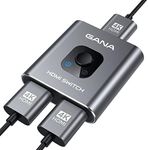
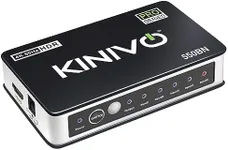
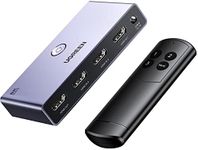
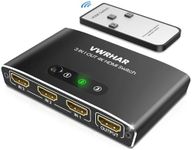
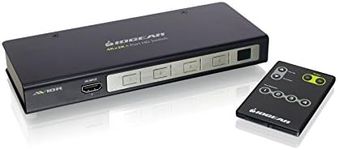

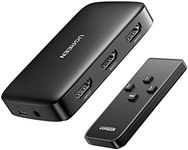





![8K 4x1 HDMI Switch 4 Inputs 1 Output | 8K 60Hz, 4K 120Hz, 1080P 240Hz | Compatible w/HDR & Dolby Vision | Supports IR Remote, Auto Switch, ALLM, VRR, QFT by J-Tech Digital [JTECH-8KSW41C]](https://images-proxy.bestreviews.guide/5NtL7nslafc0b_XkGfFQH3bPRxw=/0x150/https://m.media-amazon.com/images/I/41ruI91J-VL._AC_CX679_.jpg)



